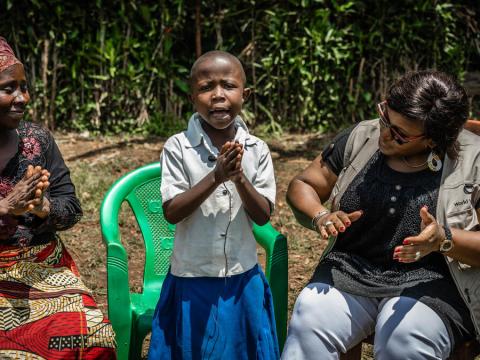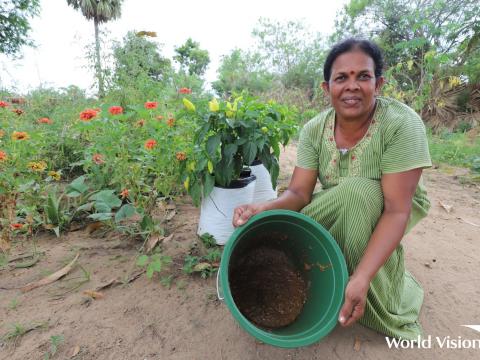
4 lessons on how savings groups protect children from harm
Livelihood experts Angeline and Yukiko lay out what World Vision has learned about how savings groups can protect children and help them flourish.
Combining savings for transformation groups (S4T) interventions with child-protection interventions, can help prevent and protect children from different forms of violence and abuse including neglect, child labour, and child marriages. Group members are taught how to budget for member’s needs, such as health and education.
World Vision’s S4T Groups Approach for Child Participation & Protection
Reducing children’s exposure to harm must go beyond empowering their parents and caregivers. Child participation brings long-term change in breaking the vicious circle of abuse within communities. As a child-focused organisation, World Vision encourages S4T group members to learn more about the importance of child protection to increase child well-being. Over 105,000 adolescent members have been supported to date by World Vision.
Children’s S4T groups: Championing Child Protection & Participation
Adolescent savings groups provide safe spaces for children to freely participate, discuss issues freely, be heard and shape their destiny. For example, in Mozambique, the Improving the Well-Being of Adolescent Girls (IWAG) project facilitated the creation of 74 adolescent S4T groups with 1,440 members, 60% of whom were girls. The groups provided social support to over 5,800 adolescents in their region. A young, female, S4T group participant said that through participating in the S4T group, “… I paid my school fees, purchased school materials and a uniform. I have also learned to stand for children and girls’ causes and fight to end child marriage and teenage pregnancy.”
In Sierra Leone, during Ebola crisis, World Vision piloted a children savings group referred to as Destiny S4T group. The S4T groups were used as a platform for championing children’s rights and speaking out against teenage pregnancy and child marriage.
In Cambodia, Prok decided to drop out of school at the age of 15 due to her mother’s illness. Her hope was restored when she joined an adolescent’s savings group, as she managed to save for her fees. She leads a children’s savings groups with around 22 other children. She said, “no one from outside will trick them to going to Thailand or the city for sex trade as other girls have fallen prey to.”
Ways World Vision Delivers on Child Protection via S4T Programming
Based on our experiences, to support our field offices deliver on child protection objectives via S4T groups, World Vision has developed supplementary child protection education modules focusing on the following four lessons:
Lesson 1: Budgeting for Child Well-Being
Promoting S4T groups alone, without training on budgeting, will not result in improved child welfare. The danger is saving for wrong reasons and not budget for essential needs, health and nutrition or for school. This lesson is aimed at equipping S4T group members to understand the basic needs of children of different age groups from conception to birth, 0-2, 2-5, 6-12, 12-18 years.
In Sierra Leone, an analysis of how Women Empowered for Leadership and Development S4T group members used their loans shows that 81.3% used S4T group loans to pay school fees, buy learning materials and pay medical expenses (60%). These S4T group members are taking care of over 40,000 children.
Lesson 2: Protecting Our Children from Harm and Abuse
This lesson is aimed at teaching S4T groups the long-term financial benefit of keeping children in school and protecting them from harm. Communities learn about their responsibilities in preventing and denouncing any forms of violence against children as well as the correct mechanisms on reporting incidents.
For example, in World Vision’s Ghana Cocoa Life project, Gladys (10) and Akousa (12), who were taken out of school when their parents tried to marry them off were rescued by a Community Child Protection Committees (CCPC) established in the Agyenkwam Community. The CCPC introduced both girls’ parents to a World Vision S4T group, which enabled them to set up trading businesses and meet their children’s basic needs. As a result, there was 50% increase in girl child education and a 50% reduction in teenage pregnancies, leading to a reduction of risk of child marriage.
Lesson 3: Preventing Harmful Work
The objective of this lesson is to ensure family businesses do not exploit or harm children.
In Ghana, meetings of S4T group members were educated on eliminating child labour. As of 2019, a total of 121 Community Child Protection Committees (932 members: 557 men, 375 women) were formed and trained for the protection of 34,415 children. This resulted in 50% increase in girl child education, 50% reduction in teenage pregnancies, leading to a reduction of risk of child marriage.
Lesson 4. The Right Time to Get Married
Protecting children from violence is connected to their family as the development and life of a child takes place within a family. This is why it is important for families to talk about effects of child marriage and how to mitigate them.
In Mozambique, IWAG S4T groups selected members from each adult S4T group to become champions for child protection and trained these members to support girls at risk of, or already exposed to, child marriage. An independent evaluation of the project found that S4T groups in the participating regions contributed to a 10.5% increase in girls’ school attendance over a period of two years (2013-2015). S4T groups provided social support to over 5,800 adolescents in their region.
An example is adolescent savings groups’ promoter Margarida, who told World Vision:
“Our major reward is that the adolescents (group members) are doing very well at school, and we never had cases of child marriage or teenage pregnancy among them. These groups are not only for saving, they are [also] a platform for child protection.”
The way forward
With the looming impacts of Covid-19 and climate change, it is important to ensure that economic-strengthening interventions, such as S4T groups, include strong child-protection components to minimise the risks of violence against children.
Parents and caregivers practise more positive parenting and create a protective environment for their children, when the following activities are incorporated into S4T groups:
- Training S4T group members on child protection and reporting mechanisms;
- Appointing S4T group members to serve on Child Protection Committees, and;
- Training Community Agents (CAs) on child protection and the role of savings group members in providing support to a community’s most vulnerable children.
For more information on S4T Child Protection Integration, download our four illustrative lesson plans for S4T facilitators to teach this alongside their corresponding flip charts from the Child Protection for Savings Groups main page.
Download our case study on Strengthening Livelihoods and preventing child marriage in times of COVID-19
Download our new (S4T) Design Guide and Implementation Guide also available in French and Spanish
Learn more about World Vision's Livelihoods programmatic approaches
Angeline Munzara, is World Vision's Global Sector Leader, Livelihoods and Yukiko Yamada is the organisation's Technical Director, Livelihoods Programming.
